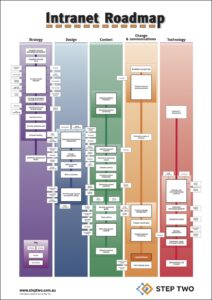
Filed under: Digital workplace, Microsoft 365
To get the most out of Microsoft 365, the transition needs to be tackled strategically, with a clear vision of the desired outcome. To assist with this strategy and planning, we released our Business-first methodology for Microsoft 365. This helps teams progress from early exploration to tangible outcomes.
A key element of the approach is the use of ‘waves’ to release new capabilities into the business, with supporting activities to make them successful. The article Launch Microsoft 365 in waves outlines two types of waves:
- People waves target specific groups of employees within an organisation (eg the call centre), and deliver a tailored mix of tools and activities to address their needs.
- Technology waves focus on a specific capability within Office 365 (eg document co-creation), and take the steps necessary to get sustainable adoption and ongoing use.
What does this look like in practice? This article explores a real-world scenario, showing how a people wave could be constructed and delivered.
A scenario
Imagine a mid-sized financial services firm, perhaps a bank or an insurance company. It has a sales force that is out on the road, making connections with potential customers and keeping in contact with existing customers. At present there is a clunky toolset that staff have to work around in order to do their jobs, often utilising ‘shadow IT’ such as Dropbox and Gmail.
With Microsoft 365 now in place in the business, there is an opportunity to support this group with modern tools that will help them deliver better sales outcomes.
Tools needed
Microsoft 365 provides a rich palette of tools that could be of assistance to these sales people.
- OneDrive can store sales presentations, including both finals and drafts.
- Teams is a rich collaboration suite that connects all the members of each sales team so they can work more closely together.
- Yammer can connect the wider group of sales people so they can share industry insights and ideas.
- SharePoint provides a ‘sales portal’ that contains authoritative documents, as well as integrating with the CRM and other business systems.
- Stream can share senior leaders’ messages and new product launches.
All of these capabilities would be designed with mobility in mind, including the use of company tablets and personal phones.
Activities required
These are the tools and capabilities that will be deployed, but there must be supporting activities to make them a success. These range from initial design and launch through to ongoing sustainability.
In practice, there are five key stages to consider as part of a people wave.
- Prepare: lay the necessary groundwork and foundation before proceeding.
- Engage: connect with the target group of employees, understand their needs, and involve them in the design process.
- Launch: conduct communication and change activities to gain initial adoption.
- Support: work hand-in-hand with employees throughout the initial period to address and resolve issues as they arise.
- Sustain: put in place ongoing processes and resources to ensure longer-term sustainability.
For our sales people, this could look like this.
| Stage | Activities |
|---|---|
| 1. Prepare |
|
| 2. Engage |
|
| 3. Launch |
|
| 4. Support |
|
| 5. Sustain |
|
These activities, combined with the tools provided, should ensure that sustainable adoption is achieved across the whole sales division.
Designing people waves in the real world

Output of a workshop exploring what a people wave could look like
As part of Step Two’s consulting services, we help teams plan and design people waves that will achieve success and deliver business value.
Assistance can range from conducting in-house workshops to build internal expertise (a sample workshop output is shown above), to directly planning people waves all the way up to determining an overall business-first approach to Microsoft 365.
Reach out, and we’ll happily talk through options and approaches.





